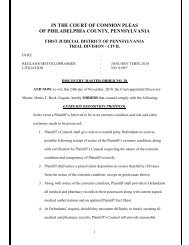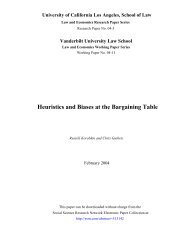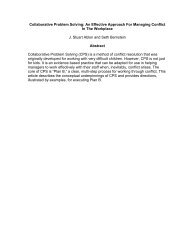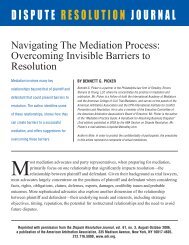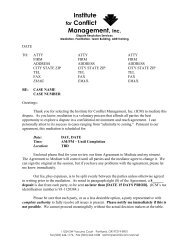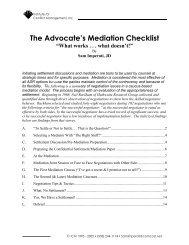ODR in Africa - Mediate.com
ODR in Africa - Mediate.com
ODR in Africa - Mediate.com
Create successful ePaper yourself
Turn your PDF publications into a flip-book with our unique Google optimized e-Paper software.
24 Onl<strong>in</strong>e Dispute Resolution for <strong>Africa</strong>Mohamed S. Abdel Wahab1 Introduction<strong>Africa</strong> is vast and rich cont<strong>in</strong>ent. It is the world’s second-largest and second most populouscont<strong>in</strong>ent. 1 With approximately more than 2000 spoken languages and around 800 dialectsused throughout <strong>Africa</strong>, 2 the Cont<strong>in</strong>ent is experienc<strong>in</strong>g an accelerated economic growth,especially <strong>in</strong> sub-Saharan low and middle <strong>in</strong><strong>com</strong>e States. The <strong>Africa</strong>n expected economicgrowth rate is at about 5.0% for 2010 and 5.5% <strong>in</strong> 2011. 3Such rich diversity, which spans the <strong>Africa</strong>n cont<strong>in</strong>ent, has certa<strong>in</strong>ly impacted its legalculture, especially the dispute resolution culture. However, ow<strong>in</strong>g to the numerous economicand technological challenges experienced by <strong>Africa</strong>, the <strong>in</strong>corporation of ICT <strong>in</strong>dispute resolution schemes has not yet been fully utilized. In fact, ICT implementation <strong>in</strong>traditional dispute resolution schemes as well as the creation of new forms of technologybased processes is still at its <strong>in</strong>ception <strong>in</strong> the overwhelm<strong>in</strong>g majority of States. To theexclusion of South <strong>Africa</strong>, Egypt, and Tunisia, which often receive the highest <strong>Africa</strong>nrank<strong>in</strong>gs <strong>in</strong> the Network Read<strong>in</strong>ess Index (NRI) developed by the World Economic Forum, 4<strong>Africa</strong>n states are grappl<strong>in</strong>g to build their ICT <strong>in</strong>frastructure and bridg<strong>in</strong>g the digitaldivide. 5 However, it is worth not<strong>in</strong>g that <strong>Africa</strong> now holds ten places <strong>in</strong> the top 100 states1 <strong>Africa</strong> hosts 54 <strong>in</strong>dependent states follow<strong>in</strong>g the split of Sudan and the creation of the Republic of SouthSudan. <strong>Africa</strong> is the second largest cont<strong>in</strong>ent after Asia, which hosts around 44 <strong>in</strong>dependent states. The<strong>Africa</strong>n cont<strong>in</strong>ent covers 6% of the Earth’s total surface area and around 20.4% of the total land mass. Itspopulation is estimated at around 1 billion people and accounts for approximately 14.72% of the world’spopulation.2 In addition to Arabic, which is an imported language spoken <strong>Africa</strong> s<strong>in</strong>ce the Arab conquest of North <strong>Africa</strong>over 1400 years ago, there are five major language families, these are: (1) Afro-Asiatic; (2) Nilo-Saharan; (3)Niger-Kordofanian; (4) Khoi-San; and (5) Austronesian. See , last accessed15 June 2011.3 IMF; World Economic Outlook, Recovery, Risk, and Rebalanc<strong>in</strong>g (2010) p. 88. Data available at, last accessed 15 June 2011.4 Accord<strong>in</strong>g to the 2011 Global Information Technology Report, Tunisia ranked 35 th , South <strong>Africa</strong> ranked61 st , and Egypt ranked 74 th on the 2010-2011 NRI. See World Economic Forum; Global InformationTechnology Report (2010-2011). Data available at ,last accessed 15 June 2011.5 The term “digital divide” denotes “the gap between <strong>in</strong>dividuals, households, bus<strong>in</strong>esses and geographic areasat different socio-economic levels with regard both to their opportunities to access <strong>in</strong>formation and <strong>com</strong>municationtechnologies (ICTs) and to their use of the Internet for a wide variety of activities. The digital dividereflects various differences among and with<strong>in</strong> countries”. See OECD; Understand<strong>in</strong>g the Digital Divide(2001) p. 5. Available at , last accessed 15 June 2011. For561
24 Onl<strong>in</strong>e Dispute Resolution for <strong>Africa</strong>on the Information Society, 8 <strong>Africa</strong>n States began to develop and boost their ICT capabilities.This <strong>in</strong>cludes due consideration of several <strong>in</strong>dicators, namely: (1) Infrastructure<strong>in</strong>dicators (Personal <strong>com</strong>puters, ma<strong>in</strong>l<strong>in</strong>es and mobiles subscribers, Internet users and 3GSubscribers, broadband usage, number of Internet hosts and security of the Internetservers); (2) Capacity <strong>in</strong>dicators (Illiteracy rates, public expenditure on education andInternational Internet bandwidth); and (3) F<strong>in</strong>ancial <strong>in</strong>dicators (Gross Domestic Product(GDP), Foreign Direct Investment (FDI) and Public and private <strong>in</strong>vestments <strong>in</strong> tele<strong>com</strong>munications).Each of these <strong>in</strong>dicators merits a mention here<strong>in</strong> below.2.1 Infrastructure IndicatorsGenerally, most countries <strong>in</strong> <strong>Africa</strong> saw an average of 10% <strong>in</strong>crease <strong>in</strong> the number of peoplewho own a personal <strong>com</strong>puter <strong>in</strong> 2006-2007, and the percentage is <strong>in</strong>creas<strong>in</strong>g at an acceleratedpace. Egypt is, by far, the country with the highest number of people own<strong>in</strong>g <strong>com</strong>puters(over three million <strong>in</strong> 2007). Conversely, the number of personal <strong>com</strong>puters <strong>in</strong> Sub-Saharan <strong>Africa</strong> (exclud<strong>in</strong>g South <strong>Africa</strong> and Nigeria) went down from seven million tojust a million between 2006 and 2007. However, the North <strong>Africa</strong>n region ma<strong>in</strong>ta<strong>in</strong>s thehighest number of people ow<strong>in</strong>g PCs amongst <strong>Africa</strong>n States. This is largely due to Egypt,Tunisia, and Morocco. 9The number of fixed l<strong>in</strong>es and mobile phone subscribers has gradually <strong>in</strong>creasedbetween 2006 and 2008. The highest rate of <strong>in</strong>crease has been witnessed by Nigeria, whichhad around thirty-four million <strong>in</strong> 2006 and jumped to over fifty-three million <strong>in</strong> 2008.Egypt ranked second; from around 28million <strong>in</strong> 2006 to over fifty-three million <strong>in</strong> 2008.The North <strong>Africa</strong>n region <strong>in</strong> general has witnessed the highest growth <strong>com</strong>pared to otherregions, although the Sub-Saharan region is experienc<strong>in</strong>g growth but at a slightly lowerrate. Central and Southern part of <strong>Africa</strong> witnessed 200% growth. This <strong>in</strong>cludes Ethiopia,Kenya, Madagascar, Tanzania and Uganda. 10 Strik<strong>in</strong>gly, both Mauritius and Seychelleshave over 1,000 subscribers per 1,000 <strong>in</strong>habitants which suggests that many people aresubscribed to more than one fixed l<strong>in</strong>e and/or mobile phone l<strong>in</strong>e. 11More specifically, from 2006 to 20008, the number of mobile phone subscribers hadsignificantly <strong>in</strong>creased. Whilst both Kenya and Egypt had much more subscribers, Ethiopiahad fewer than one million <strong>in</strong> 2006 and three million <strong>in</strong> 2008. The Sub Saharan region sawlarge <strong>in</strong>creases, basically double the amount of subscribers <strong>in</strong> 2008 <strong>com</strong>par<strong>in</strong>g to 2006. 128 See , last accessed 15 June 2011.9 World Bank; <strong>Africa</strong> Development Indicators (March 2010); data available at ,last accessed 15 June 2011.10 Id.11 Id.12 Id.563
Mohamed S. Abdel WahabThere has also been notable growth <strong>in</strong> some <strong>Africa</strong>n countries with respect to subscriptionto 3G applications and services. In 2009, some countries witnessed annual growth ofmore than 100%. For example, Libya had over 300% growth, Morocco had more than200%, and South <strong>Africa</strong> had more than 100%. Egypt only witnessed 83% growth. It is worthhighlight<strong>in</strong>g that Tanzania experienced a notable decrease by 22%. 13With respect to Internet users, there has been an <strong>in</strong>crease of nearly fifteen millionpeople between 2006 and 2008. Egypt, Morocco, and Nigeria had the highest number ofInternet users. The Sub-Saharan develop<strong>in</strong>g region had over thirty-five million users <strong>in</strong>2008, which means that despite hav<strong>in</strong>g relatively low number of personally owned PCs,people, <strong>in</strong> this region, still had adequate access to the Internet. The North <strong>Africa</strong>n regionranked second with respect to the highest penetration of Internet users, largely due to bothEgypt and Morocco. 14With respect to broadband access, some countries have witnessed exponential growthsuch as Mauritius, Mauritania, Egypt, and Tunisia, which had large <strong>in</strong>creases <strong>in</strong> broadbandsubscribers between 2006 and 2008. 15 On the other hand, the Sub-Saharan develop<strong>in</strong>gregion experienced a decrease <strong>in</strong> this context. 16 The North <strong>Africa</strong>n region witnessed an<strong>in</strong>crease to nearly 1.5 million <strong>in</strong> 2008 <strong>com</strong>pared to only 0.8 million <strong>in</strong> 2006. 17Between 2006 and 2008, International Internet bandwidth (bits per person) has <strong>in</strong>creased<strong>in</strong> Egypt, Cape Verde, and Mauritius. Tunisia, Sudan, Morocco and Seychelles, where theyhave witnessed massive <strong>in</strong>crease from as little as five bits per person to well over 1,000 bitsper person. 18With respect to the number of Internet hosts across <strong>Africa</strong>n countries, this largelydiffers. Generally, the North <strong>Africa</strong>n region has developed a high number of Internet hosts<strong>in</strong> 2010, with ma<strong>in</strong>ly Egypt conta<strong>in</strong><strong>in</strong>g over 187,000 hosts and Morocco hav<strong>in</strong>g over 277,000hosts. 19 Surpris<strong>in</strong>gly, Tunisia had only 490 hosts <strong>in</strong> 2010. 20 It is worth mention<strong>in</strong>g thatwhilst Egypt has a higher number of PC owners than Morocco, the latter has more Internethosts. It is also worth not<strong>in</strong>g that whilst Ghana has over 41,000 Internet hosts, Nigeriaonly had 1,300 hosts <strong>in</strong> 2010, despite the fact that the latter State has a high Internet penetrationrate. 21 Nonetheless, South <strong>Africa</strong> has, by far, the highest number of Internet hoststhroughout the whole of <strong>Africa</strong>, with over three million servers, despite the fact that South13 Id.14 Id.15 Id.16 Id.17 Id.18 Id.19 Central Intelligence Agency; The World Fact book (2010); data available at, last accessed15 June 2011.20 Id.21 Id.564
24 Onl<strong>in</strong>e Dispute Resolution for <strong>Africa</strong><strong>Africa</strong>, when <strong>com</strong>pared to Egypt and Morocco, had lower Internet penetration rates withonly over four million. 22With respect to secure Internet servers, which are <strong>in</strong>dispensable for secure e-<strong>com</strong>merceand <strong>ODR</strong> applications, the security thereof has been ga<strong>in</strong><strong>in</strong>g due attention <strong>in</strong> the majorityof <strong>Africa</strong>n States s<strong>in</strong>ce 2006. Whilst South <strong>Africa</strong> hosts the highest number of secure servers,both Nigeria and Tunisia have over 100 secure servers. Egypt, although hav<strong>in</strong>g the highestnumber of owned PCs and very high Internet penetration rate as previously mentioned,is still provid<strong>in</strong>g fewer secure servers when <strong>com</strong>pared to Tunisia or Nigeria. 232.2 Capacity IndicatorsGiven the fact that most <strong>Africa</strong>n states are develop<strong>in</strong>g nations, this certa<strong>in</strong>ly impacts educationand illiteracy rates, which seem to be quite high <strong>in</strong> some <strong>Africa</strong>n countries. Despitethe high number of Internet users <strong>in</strong> Egypt, the basic illiteracy rate is 34% of people agedfifteen years and above. 24 Morocco suffers from 44% illiteracy rate. 25 Senegal equally hasa high illiteracy rate of 58%, despite the colossal <strong>in</strong>crease <strong>in</strong> Internet users between 2006and 2008. 26 The highest illiteracy rates tend to exist <strong>in</strong> Chad (68%), Burk<strong>in</strong>a Faso and Niger(71%), and Mali with the highest rate <strong>in</strong> <strong>Africa</strong> (74%). 27 On the other hand, Zimbabwe hasthe lowest rate (9%). 28 In all <strong>Africa</strong>n countries, it seems evident that females are suffer<strong>in</strong>gfrom more illiteracy than males, which makes it <strong>in</strong>terest<strong>in</strong>g to assess the correlation betweengender illiteracy and gender Internet usage <strong>in</strong> these countries. 29The percentage of public expenditure on education <strong>in</strong> general seems low, with Lesothohav<strong>in</strong>g the highest (12.4%) and Chad be<strong>in</strong>g one of the lowest (1.9%). 30 Both Egypt andMorocco have spent as low as (3.7%) and (5.5%), respectively. Conversely, <strong>in</strong> the Southern<strong>Africa</strong>n region, some countries tend to have high expenditure rate such as Botswana (8.1%)and Swaziland (8.3%) even though both experience relatively low Internet usage as wellas low Foreign Direct Investment (FDI). In the Northern region, Tunisia seemed to have22 Id.23 World Bank; <strong>Africa</strong> Development Indicators (March 2010); data available at ,last accessed 15 June 2011.24 Organization for Economic Co-operation and Development; <strong>Africa</strong>n Economic Outlook; Data & Statistics;Table 18, Basic Education Indicators, Excel spreadsheet (2011); available at , last accessed 9 June 2011.25 Id.26 Id.27 Id.28 Id..29 Id..30 Id..565
Mohamed S. Abdel Wahabspent slightly more than Egypt and Morocco, and this is <strong>in</strong>deed reflected <strong>in</strong> the lower levelsof illiteracy. 312.3 F<strong>in</strong>ancial IndicatorsAccord<strong>in</strong>g to the latest verified statistical <strong>in</strong>formation, the period between 2006 and 2009shows that the average growth rate of real GDP <strong>in</strong> <strong>Africa</strong> is 5% per year except for 2009where the growth rate was lower than usual ow<strong>in</strong>g to the global f<strong>in</strong>ancial crisis that sweptthe world <strong>in</strong> 2008. 32Generally, <strong>in</strong> both 2006 and 2007, 6% of GDP <strong>in</strong> the whole of <strong>Africa</strong> was spent on ICT.It is <strong>in</strong>terest<strong>in</strong>g to note that the North <strong>Africa</strong>n region had spent 5% of their GDP, ma<strong>in</strong>lydue to Algeria, Egypt, Tunisia and Morocco. South <strong>Africa</strong> and Senegal spent 10% and 11%,respectively. 33 The figures provided for 2006 were exactly the same for 2007. Thus, therewere no deviations <strong>in</strong> expenditure <strong>in</strong> both years. 34With respect to FDI, it has witnessed fundamental changes between 2006 and 2009.Whilst some countries have benefited from an <strong>in</strong>crease, others have suffered from a decrease<strong>in</strong> FDI. Angola had the highest FDI, with 13,101 million USD <strong>in</strong> 2009. 35 In addition,Algeria, Ghana, Niger and Equatorial Gu<strong>in</strong>ea witnessed a strong <strong>in</strong>crease <strong>in</strong> FDI. 36 On theother hand, Kenya exhibited a mixture of both an <strong>in</strong>crease and decrease between 2006 and2009, where it was 51 million USD <strong>in</strong> 2006, 729 million USD <strong>in</strong> 2007, 96 million USD <strong>in</strong>2008, and 141 million <strong>in</strong> 2009. 37 In 2009, Morocco witnessed a decrease of FDI outflows<strong>com</strong>pared to 2007, dropp<strong>in</strong>g from 621 million USD <strong>in</strong> 2007 to 470 million USD <strong>in</strong> 2009.Moreover, their FDI <strong>in</strong>flows <strong>in</strong> 2009 decreased by almost half from 2487 million USD <strong>in</strong>31 Id.32 Organization for Economic Co-operation and Development; <strong>Africa</strong>n Economic Outlook; Data & Statistics(2011); data available at ,last accessed 15 June 2011.33 World Bank; <strong>Africa</strong> Development Indicators (March 2011); data available at ,last accessed 15 June 2011.34 Id.35 Organization for Economic Co-operation and Development; <strong>Africa</strong>n Economic Outlook; Data & Statistics(2011); data available at ,last accessed 9 June 2011.36 Organization for Economic Co-operation and Development; <strong>Africa</strong>n Economic Outlook; Data & Statistics(2011). From 2006 to 2009, FDI <strong>in</strong>creased from 1795 million USD to 2847 million <strong>in</strong> Algeria, 636 to 1685million USD <strong>in</strong> Ghana, 470 to 1636 million USD <strong>in</strong> Equatorial Gu<strong>in</strong>ea and 51 to 739 million USD <strong>in</strong> Niger.Data available at , last accessed 9 June 2011.37 Organization for Economic Co-operation and Development; <strong>Africa</strong>n Economic Outlook; Data & Statistics(2011); data available at ,last accessed 9 June 2011.566
24 Onl<strong>in</strong>e Dispute Resolution for <strong>Africa</strong>2008 to 1331 million USD <strong>in</strong> 2009. 38 Libya had the highest outflow of <strong>in</strong>vestments of 5888million USD <strong>in</strong> 2008 but sharply decreased to 1165 million USD <strong>in</strong> 2009. 39 Egypt’s outflowof FDI <strong>in</strong>creased from 148 million USD <strong>in</strong> 2006 to 1920 million USD <strong>in</strong> 2008, but decreasedto 571 million USD <strong>in</strong> 2009, which equally occurred with respect to Egypt’s FDI <strong>in</strong>flowsthat decreased from 9495 <strong>in</strong> 2008 to 6712 <strong>in</strong> 2009. 40 South <strong>Africa</strong> had a negative outflowof FDI of 3533 million USD <strong>in</strong> 2008 which <strong>in</strong>creased <strong>in</strong> 2009 to 1584 million USD and animportant <strong>in</strong>crease of 9009 million USD <strong>in</strong> 2008 of FDI <strong>in</strong>flows <strong>com</strong>pared to 5695 millionUSD <strong>in</strong> the previous year, followed by an important decrease <strong>in</strong> 2009 with an FDI <strong>in</strong>flowof 5696 million USD. 41In the context of ICT, <strong>in</strong>vestments <strong>in</strong> tele<strong>com</strong>munications with private participation<strong>in</strong> most <strong>Africa</strong>n countries generally decreased between 2006 and 2007. However, <strong>in</strong>Cameroon, Ghana, Senegal, and Liberia <strong>in</strong>vestments <strong>in</strong>creased by a high proportion. 42North <strong>Africa</strong>, witnessed a decrease <strong>in</strong> ICT <strong>in</strong>vestments, and specifically <strong>in</strong> Tunisia therewas a dramatic drop. 43 However the Sub-Saharan region witnessed some important <strong>in</strong>crease<strong>in</strong> <strong>in</strong>vestments, especially <strong>in</strong> the Niger, Chad, Swaziland, and Malawi. 44In light of the above succ<strong>in</strong>ct overview of the diverse <strong>in</strong>dicators and factors that determ<strong>in</strong>e<strong>Africa</strong>n States’ ICT read<strong>in</strong>ess, it seems plausible to dist<strong>in</strong>guish between three differentgroups of <strong>Africa</strong>n States: (1) ICT ready States such as South <strong>Africa</strong>, Egypt, Morocco andTunisia; (2) ICT progress<strong>in</strong>g States such as Nigeria, Cameroon, Tanzania, Algeria, Seychelles,and Ghana and (3) ICT potentially progress<strong>in</strong>g States such as Botswana, Malawi,Zambia, Central <strong>Africa</strong>, Chad, Niger, Gu<strong>in</strong>ea, Somalia, Ethiopia, Burk<strong>in</strong>a Faso, SierraLeone, Ivory Coast, Burundi, and Rwanda.38 Id.39 Id.40 Id.41 Organization for Economic Co-operation and Development; <strong>Africa</strong>n Economic Outlook; Data & Statistics(2011); data available at ,last accessed 15 June 2011.42 World Bank; <strong>Africa</strong> Development Indicators (March 2011). From 2006 to 2007, <strong>in</strong>vestment <strong>in</strong> tele<strong>com</strong>s withprivate participation <strong>in</strong>creased <strong>in</strong> Cameroon from 63 million USD to more than 149 million USD, <strong>in</strong> Ghanafrom 215 million to 420 million USD, <strong>in</strong> Senegal from 212 million to 567 million USD and <strong>in</strong> Liberia frommore than 10 million USD to 17 million USD. Data Available at ,last accessed 15 June 2011.43 World Bank; <strong>Africa</strong> Development Indicators (March 2011). From 2006 to 2007, Tunisia witnessed a dropof <strong>in</strong>vestment <strong>in</strong> tele<strong>com</strong>s with private participation from 2343 million USD to 76 million USD. DataAvailable at , last accessed15 June 2011.44 World Bank; <strong>Africa</strong> Development Indicators (March 2011). From 2006 to 2007, <strong>in</strong>vestment <strong>in</strong> tele<strong>com</strong>s withprivate participation <strong>in</strong>creased <strong>in</strong> Niger from 0 to 110 million USD, <strong>in</strong> Chad from more than 26 millionUSD to more than 53 million USD, <strong>in</strong> Swaziland from 0 to almost 4 million USD and <strong>in</strong> Malawi from morethan 30 million to 37 million USD. Data available at ,last accessed 15 June 2011.567
Mohamed S. Abdel WahabIt is also manifest that the proliferation of <strong>ODR</strong> <strong>in</strong> <strong>Africa</strong> is decelerated by the scarcityof adequate ICT <strong>in</strong>frastructure and capacity <strong>in</strong>dicators. This seems to be chang<strong>in</strong>g <strong>in</strong> lightof the relative <strong>in</strong>crease <strong>in</strong> f<strong>in</strong>ancial <strong>in</strong>dicators, especially FDI and ICT expenditure. Nevertheless,enhanc<strong>in</strong>g ICT <strong>in</strong>frastructure and develop<strong>in</strong>g capacity to offer state-of-the-art<strong>ODR</strong> services h<strong>in</strong>ge not only on ICT, capacity, and f<strong>in</strong>ancial read<strong>in</strong>ess, but also on theexistence of adequate socio-legal <strong>in</strong>frastructure that provides <strong>com</strong>patible regulatoryframework that boosts trust and confidence. This would ultimately create cultural read<strong>in</strong>essfor <strong>ODR</strong> <strong>in</strong> <strong>Africa</strong>.On such account, it seems necessary to provide a brief overview of <strong>ODR</strong> related legaland regulatory frameworks <strong>in</strong> some of the ICT ready and progress<strong>in</strong>g <strong>Africa</strong>n States, whichwill eventually support fully-fledged <strong>ODR</strong> schemes.3 ICT Laws and Regulations: Boost<strong>in</strong>g E-Trust and E-ConfidenceThe <strong>in</strong>dispensability of adequate socio-legal and regulatory framework for <strong>ODR</strong> has beenemphasized by UNCTAD, which stated:The need for an appropriate legal framework that is supportive of and conduciveto the practice of e-<strong>com</strong>merce has been identified as a prerequisite for thegrowth of e-<strong>com</strong>merce <strong>in</strong> general and <strong>ODR</strong> <strong>in</strong> particular. 45At the outset, the majority of <strong>Africa</strong>n and Middle Eastern States are predom<strong>in</strong>antly legislationcentric. In other words, the prevail<strong>in</strong>g legal culture <strong>in</strong> such regions is founded onstatutory <strong>in</strong>struments, which serves a dual purpose, that is: (a) regulat<strong>in</strong>g specific sectors,services, and/or activities; and (b) boost<strong>in</strong>g public trust and confidence <strong>in</strong> such regulatedservices and activities. That said, the proliferation of ICT applications and services, especially<strong>ODR</strong> schemes, require the existence of a solid matrix of support<strong>in</strong>g laws and regulations. 46On such account, <strong>Africa</strong> generally lacks sufficient ICT and <strong>ODR</strong> oriented legislative<strong>in</strong>struments, <strong>in</strong>clud<strong>in</strong>g, but not limited to, the full recognition of electronic data messagesand <strong>com</strong>munications, e-<strong>com</strong>merce, and/or data protection. Nevertheless, some ICT readyand progress<strong>in</strong>g <strong>Africa</strong>n States, such as Egypt, Tunisia, Morocco, Algeria, and South <strong>Africa</strong>,45 UNCTAD; “E-Commerce and Development Report 2003” (2003); Chapter 7: “Onl<strong>in</strong>e Dispute Resolution:E-Commerce and Beyond.” data available at , last accessed15 June 2011.46 It is worth not<strong>in</strong>g that other regions and countries may pr<strong>in</strong>cipally rely on market practices irrespective ofany statutory <strong>in</strong>struments. This is generally accepted <strong>in</strong> advanced and highly developed states, where theState generally opts for a non-<strong>in</strong>terventionist approach, due to powerful market forces that efficiently contributeto the development and shap<strong>in</strong>g of the relevant norms and practices.568
24 Onl<strong>in</strong>e Dispute Resolution for <strong>Africa</strong>have witnessed, over the past few years, a proliferation of several legislative <strong>in</strong>itiatives thatsupport ICT applications and services.Prior to embark<strong>in</strong>g on a brief survey of such <strong>in</strong>itiatives, it seems <strong>in</strong> order to identifythe pert<strong>in</strong>ent key legislative <strong>in</strong>struments that support ICT. These <strong>in</strong>clude (A) E-<strong>com</strong>merce,E-contract<strong>in</strong>g, and Digital Signature, (B) E-evidence (admissibility and evidentiary weight),and (C) Protective Laws (Intellectual Property Rights, Consumer Protection, and Informationand Cyber-security regulation).3.1 E-Commerce & Digital Signature LawsE-<strong>com</strong>merce allows consumers and bus<strong>in</strong>esses to conduct bus<strong>in</strong>ess through electronicmeans on national, regional, and global levels. Whilst most advanced <strong>Africa</strong>n countrieshave adequate e-<strong>com</strong>merce norms <strong>in</strong> place, less developed regions and states are <strong>in</strong>creas<strong>in</strong>glyrecogniz<strong>in</strong>g the importance of an e-<strong>com</strong>merce legal framework.In Egypt, the accelerated growth <strong>in</strong> Internet usage and utilization has prompted thedevelopment of B2B and B2C e-<strong>com</strong>merce and regulation, 47 which has resulted <strong>in</strong> theenactment of the Digital Signatures Law No. 15 of 2004 (E-Sign Law) and the establishmentof the Information Technology Industry Development Agency (ITIDA) <strong>in</strong> 2004. 48 ITIDAsupports the development of ICT <strong>in</strong> Egypt through the follow<strong>in</strong>g <strong>in</strong>terdiscipl<strong>in</strong>ary <strong>in</strong>itiatives:(i) Research and Innovation Support, which aims at support<strong>in</strong>g the development of mature<strong>in</strong>novation management systems <strong>in</strong> Egyptian ICT SMEs that would enable such entitiesto <strong>in</strong>troduce <strong>com</strong>petitive <strong>in</strong>novative ICT products and services <strong>in</strong>to the marketplace;lead<strong>in</strong>g to a considerable boost to Egypt’s national GDP; (ii) Small and Medium Enterprises,which are important to the growth of Egypt’s ICT sector. Ow<strong>in</strong>g to Egypt’s tax, customand f<strong>in</strong>ancial sector reforms, it has acquired a strong position to provide outstand<strong>in</strong>g<strong>in</strong>cubation management to seed and startup IT <strong>com</strong>panies and boost employment skillsthrough tra<strong>in</strong><strong>in</strong>g schemes; (iii) Enterprise International Certification through participat<strong>in</strong>g<strong>in</strong> a number of <strong>in</strong>ternational certification programs to achieve recognition and certificationof Egyptian <strong>com</strong>panies and improve their skill base; (iv) Information Technology AcademiaCollaboration (ITAC), which aims at promot<strong>in</strong>g and <strong>in</strong>centiviz<strong>in</strong>g research projects thatbr<strong>in</strong>g value to IT <strong>com</strong>panies, universities, research centers and the wider technological<strong>com</strong>munity <strong>in</strong> Egypt, and has been designed to l<strong>in</strong>k <strong>in</strong>dustry research with market needs;47 B2C e-<strong>com</strong>merce sites <strong>in</strong> Egypt <strong>in</strong>clude stock market trad<strong>in</strong>g, real property, food delivery, lifestyle products,Egyptian handicrafts, furniture and human-resources <strong>in</strong>dustries.48 ITIDA is the executive IT arm of the Egyptian M<strong>in</strong>istry of Communications and Information Technology,MCIT. With local and <strong>in</strong>ternational outreach, ITIDA plays a fundamental role as a one-stop-shop for foreigndirect <strong>in</strong>vestors seek<strong>in</strong>g to enhance their global offer<strong>in</strong>g us<strong>in</strong>g Egypt’s <strong>com</strong>petitive advantages. ITIDA activelypursues two broad goals: (i) build<strong>in</strong>g the capacities of Egypt’s ICT sector, and (ii) attract<strong>in</strong>g FDI to boostthe ICT sector locally and globally. See , last accessed 9 June 2011.569
Mohamed S. Abdel Wahab(v) Industry Development through support<strong>in</strong>g local Egyptian bus<strong>in</strong>esses and <strong>in</strong>creas<strong>in</strong>gtheir <strong>in</strong>ternational exports; and (vi) Community Awareness through prioritiz<strong>in</strong>g thedevelopment of the software <strong>in</strong>dustry whilst <strong>in</strong>creas<strong>in</strong>g social awareness of <strong>in</strong>tellectualproperty issues. As a result of these programs, Egypt’s piracy rat<strong>in</strong>g has dropped from 69%<strong>in</strong> 2003 to 59% <strong>in</strong> 2009 accord<strong>in</strong>g to the seventh annual BSA and IDC Global SoftwarePiracy Study. 49With respect to E-signature services for the public and private sectors, such serviceswere launched on 28 September 2009 together with the <strong>in</strong>auguration of the Egyptian Root-CA trust center, mark<strong>in</strong>g the e-signature authorization system by the ITIDA. ITIDA, asa supervisory body for electronic signature, operates the Egyptian Root CertificateAuthority (Root CA) and the E-signature CA Licens<strong>in</strong>g Unit. The Root CA will issue digitalcertificates to subord<strong>in</strong>ate Certificate Service Providers (CSP) to provide the proper<strong>in</strong>frastructure for the use of E-signature <strong>in</strong> Egypt. The Egyptian E-signature CA Licens<strong>in</strong>gUnit has been set up to audit the E-signature service providers <strong>com</strong>panies <strong>in</strong> Egypt, address<strong>com</strong>pla<strong>in</strong>ts, offer technical counsel<strong>in</strong>g <strong>in</strong> collaboration with the Root CA panel, andmediate between disput<strong>in</strong>g parties, form<strong>in</strong>g part of the ICT Industry ombudsman with<strong>in</strong>ITIDA framework. A limited number of Egyptian E-signature Service Providers (ESPs)have been licensed by the E-signature CA Licens<strong>in</strong>g Unit, <strong>in</strong> order to provide e-signatureservices, issue digital certificates and correspond<strong>in</strong>g electronic signatures for citizens andprivate sector <strong>com</strong>panies’ clients. 50With respect to IPR, the new IPR Law No. 82 of 2002 unifies and supersedes exist<strong>in</strong>g<strong>in</strong>tellectual property laws, some of which date back over half a century. It is designed tobr<strong>in</strong>g Egypt’s legislation <strong>in</strong>to <strong>com</strong>pliance with the Trade-Related Aspects of IntellectualProperty Rights (TRIPS) Agreement. The Law covers copyrights, models and <strong>in</strong>dustrialdesigns, patents of <strong>in</strong>vention, utility models, layout designs of <strong>in</strong>tegrated circuits, undisclosed<strong>in</strong>formation, and trademarks. 51 This Law has contributed to the creation of anenvironment that encourages creativity and boosts FDI.49 See , last accessed 9 June 2011.50 To-date, there are four licensed <strong>com</strong>panies: Security & Network Services (“SNS”), Misr for Central Clear<strong>in</strong>g,Depository and Registry (“MCDR”), Egypt Trust, and Advanced Computer Technology (“ACT”). The listof licensed <strong>com</strong>panies and their contact <strong>in</strong>formation is available at ,last accessed 9 June 2011.51 Although Law No. 82 of 2002 expands the scope of protection so as to <strong>in</strong>clude items that have not beenprotected before such as utility models, topographies of <strong>in</strong>tegrated circuits and undisclosed <strong>in</strong>formation,yet it does not provide an explicit reference to the protection of ICT applications <strong>in</strong> the context of IPR except<strong>in</strong> the context of copyright protection. For example, explicit reference was made <strong>in</strong> Article (138) to the audioor audio-visual transmission of work, performance, phonogram or the work or performance record<strong>in</strong>g, tothe public by wireless means <strong>in</strong>clud<strong>in</strong>g satellite broadcast<strong>in</strong>g. Moreover, Article (140) states that rights ofthe authors to their literary and artistic works shall be protected by the law here<strong>in</strong>, and particularly <strong>com</strong>putersoftware and databases which are either legible by <strong>com</strong>puter or by any other device. Furthermore, Article(181) provides for penalties by imprisonment for not less than one month and/or a f<strong>in</strong>e of not less than5,000 Egyptian pounds, and not exceed<strong>in</strong>g 10,000 Egyptian pounds, for publish<strong>in</strong>g a work, phonogram,570
24 Onl<strong>in</strong>e Dispute Resolution for <strong>Africa</strong>Moreover, Egypt has enacted the Tele<strong>com</strong>munication Law No. 10 of 2003. This Lawaims at reorganiz<strong>in</strong>g the tele<strong>com</strong>munications sector, and is based on some fundamentalpr<strong>in</strong>ciples, amongst which are: universal access, party autonomy, protection of users, andencourag<strong>in</strong>g <strong>in</strong>vestment <strong>in</strong> the ICT sector. The Law established the National Tele<strong>com</strong>municationsRegulatory Authority (NTRA), which is entrusted with the organization of thetele<strong>com</strong>munications utility and issu<strong>in</strong>g tele<strong>com</strong>munications licenses <strong>in</strong> accordance withthe above-mentioned fundamental pr<strong>in</strong>ciples. The Law also provides for severe penaltiesof imprisonment for a period not less than three months and/or a f<strong>in</strong>e not less than L.E5,000 and not exceed<strong>in</strong>g L.E. 5,0000 for the publish<strong>in</strong>g, record<strong>in</strong>g, hid<strong>in</strong>g, obstruct<strong>in</strong>g,modify<strong>in</strong>g, and/or refra<strong>in</strong><strong>in</strong>g from send<strong>in</strong>g the contents of a <strong>com</strong>munications message orpart of it without hav<strong>in</strong>g any legal basis for such action. The same penalties apply fordivulg<strong>in</strong>g <strong>in</strong>formation concern<strong>in</strong>g users of <strong>com</strong>munication networks and their <strong>com</strong>munication.52In Morocco, the Moroccan Law No. 53-05 for electronic exchange of legal data wasenacted <strong>in</strong> 30 November 2007. 53 The Law governs the electronic signature legal framework<strong>in</strong> Morocco and regulates electronic certification and cryptography. The Law modifiesand <strong>com</strong>plements Articles (417), (425), (426), (440), and (443) of the Moroccan Civil Codeand was adopted a month after the decision of the Professional Group of Moroccan Bank(Groupement Professionnel des Banques Maroca<strong>in</strong>es) allow<strong>in</strong>g onl<strong>in</strong>e payment withMoroccan credit cards. 54Accord<strong>in</strong>g to Article (6) of the Moroccan Law, a secure electronic signature is producedby a device for creat<strong>in</strong>g electronic signatures attested by a certificate of <strong>com</strong>pliance issuedby the National Tele<strong>com</strong>munications Regulatory Agency (ANRT), designated as theNational Authority for Approval and Monitor<strong>in</strong>g of Electronic Certification. Its role istherefore to accredit providers of electronic certification.The Executive Regulations of the Law were enacted two years later and specifically on18 June 2009. 55 The Regulations addressed means of encrypt<strong>in</strong>g data messages and condibroadcastor performance protected pursuant to the provisions of the law here<strong>in</strong> via <strong>com</strong>puters, Internet,<strong>in</strong>formation networks, <strong>com</strong>munication networks or any other means, without hav<strong>in</strong>g prior written permissionfrom the author or holder of the neighbour<strong>in</strong>g right.52 See Article (73) of the Tele<strong>com</strong>munications Law.53 Loi No. 53-05 relative à l’échange électronique de données juridiques. Available at ,last accessed 15 June 2011.54 Commerce électronique au Maroc (E-Commerce <strong>in</strong> Morocco), Onl<strong>in</strong>e publication, July 2010. Available at, last accessed 15 June 2011.55 Décret n° 2-08-518 du 25 joumada I 1430 pris pour l’application des articles 13, 14, 15, 21 et 23 de la loi n°53-05 relative à l’échange électronique des données juridiques (Decree No.2-08-518 of 25 JoumadaI 1430execut<strong>in</strong>g Articles 13, 14, 15, 21 and 23 of Law No. 53-05 for electronic exchange of legal data); OfficialBullet<strong>in</strong> No. 5744; 18 June 2009. Available at ,last accessed 15 June 2011.571
Mohamed S. Abdel Wahabtions for electronic certification of providers request<strong>in</strong>g accreditation. Nevertheless, hitherto,no provider has been accredited. Only some public agencies, through their <strong>in</strong>ternal certificationprocess, provide electronic signature services. For example, the Moroccan NationalSocial Security Fund (CNSS) has its own certification authority and thus offers employersthe opportunity to report and pay payroll taxes over the Internet through its websitedaman<strong>com</strong>.ma. In essence, e-government services have preceded e-<strong>com</strong>merce and B2Btransactions <strong>in</strong> Morocco. 56In Tunisia, the Electronic Exchange and Electronic Commerce Law was enacted s<strong>in</strong>ce9 August 2000. 57 This Law, which is certa<strong>in</strong>ly <strong>in</strong>spired by the French Law No. 2000-230 of13 March 2000, deals with electronic signatures and affords e-signatures and e-documentsthe same evidentiary weight afforded to paper-based documents <strong>in</strong> so far as the authenticityconditions are fulfilled. In Tunisia, the electronic signatures system uses the public key<strong>in</strong>frastructure (PKI) system/encryption, which is the same technology utilized under theEgyptian E-Sign Law. 58The Executive Regulations of the Tunisian Law have been adopted <strong>in</strong> 2001 by virtueof the Decree No. 2001-1667 of 17 July 2001, which establishes specifications for undertak<strong>in</strong>gthe activity of electronic certification services provider. Moreover, Decree No. 2001-1668 of 2001 has laid down the procedure for obta<strong>in</strong><strong>in</strong>g permission to carry out the activityof electronic certification services provider, and Decree No. 2001-2727 of 20 November2001 sets the conditions and procedures to use cryptography and encryption. Furthermore,two <strong>in</strong>ternal order (Arrêtés) of the Tunisian M<strong>in</strong>istry of Communication and Technologiesof 19 July 2001 have determ<strong>in</strong>ed the technical specifications for digital certificates, theirreliability and technical characteristics of the device creat<strong>in</strong>g electronic signatures.In Algeria, a legislative amendment of Articles (323 bis), (323 bis 1) and (327) ofAlgerian Civil Code has been passed <strong>in</strong> April 2005, allow<strong>in</strong>g the use of electronic evidence.However, Algeria has not yet adopted a separate and specific legislation on electronic signatures.Two draft laws should have been f<strong>in</strong>alized by the first part of 2010, but no <strong>in</strong>dicationhas been found show<strong>in</strong>g that those drafts have now been enacted. 59 The first of thesedraft laws aims at regulat<strong>in</strong>g electronic exchanges and <strong>in</strong>cludes provisions relat<strong>in</strong>g to56 It is also worth not<strong>in</strong>g that Egypt offers a number of e-government services to citizens, bus<strong>in</strong>esses, and foreignersthrough its government portal. See , last accessed 9 June 2011.57 Loi No. 2000-83 du 9 août 2000, relative aux échanges et au <strong>com</strong>merce éléctronique (Electronic Exchange andElectronic Commerce Law), 9 August 2000. Available at ,last accessed 15 June 2011.58 It is worth not<strong>in</strong>g that both Egyptian and Tunisian Laws are not technology neutral but have specificallyopted for a PKI system to the exclusion of new technologies such biometrics. This is quite questionable,especially that technology specific laws are generally undesirable ow<strong>in</strong>g to the fact that technological applicationsbe<strong>com</strong>e antediluvian with<strong>in</strong> a relatively short time span.59 Anonymous Author, “Algérie: Un projet de loi pour sécuriser Internet (Algeria: draft law to secure Internet)”,Le quotidien d’Oran (Oran Daily Newspaper), Onl<strong>in</strong>e Publication, 10 May 2010. Available at , last accessed 15 June 2011.572
24 Onl<strong>in</strong>e Dispute Resolution for <strong>Africa</strong>electronic certificates, electronic signature and cryptography. The second one is relatedto the protection of personal data and aims at ma<strong>in</strong>ta<strong>in</strong><strong>in</strong>g a strict framework for the protectionof Internet users.On a different note, leav<strong>in</strong>g the North <strong>Africa</strong>n region to South <strong>Africa</strong>, it seems evidentthat e-<strong>com</strong>merce <strong>in</strong> <strong>in</strong>creas<strong>in</strong>gly utilized <strong>in</strong> South-<strong>Africa</strong>. The Tele<strong>com</strong>munications ActNo. 103 of 1996 has generated a matrix of legislative <strong>in</strong>struments. The 1996 Act wasamended by the Tele<strong>com</strong>munications Amendment Act No. 12 of 1997, the IndependentCommunications Authority of South <strong>Africa</strong> Act No.13 of 2000, and the Tele<strong>com</strong>municationsAmendment Act No. 64 of 2001. In July 2001, the Independent CommunicationsAuthority of South <strong>Africa</strong> (ICASA) was established and merged both the Tele<strong>com</strong>s Regulator(Tele<strong>com</strong>munications Regulators Association of Southern <strong>Africa</strong>) and the Broadcast<strong>in</strong>gRegulator (Independent Broadcast<strong>in</strong>g Authority).In July 2006, the Electronic Communications Act (ECT) was promulgated <strong>in</strong> 2002 toregulate and promote electronic <strong>com</strong>munications and transactions, consumer protection,e-government services and e-signatures. 603.2 E-Evidence RegimeOw<strong>in</strong>g to the fact that diverse <strong>ODR</strong> schemes <strong>in</strong>volve electronic exchange of documents,which may very well be <strong>in</strong>tr<strong>in</strong>sically electronic <strong>in</strong> nature and format, the validity and evidentiaryweight of e-documents be<strong>com</strong>e <strong>in</strong>dispensable. Accord<strong>in</strong>gly, e-evidence denotesthe legal value and admissibility of electronic, and electronically exchanged, data.In technology ready <strong>Africa</strong>n States, it is <strong>in</strong>controvertible that e-documents and e-dataare admissible as e-evidence, and are afforded the same evidentiary weight as standardpaper based documents. In Egypt, Articles (14) and (15) of the E-Sign Law states thate-signatures and e-documents shall have the same determ<strong>in</strong>ative and evidentiary effectthat standard paper based signatures, writ<strong>in</strong>g, official and unofficial <strong>com</strong>munications haveunder the Code of Evidence. Moreover, Article (16) of the E-Sign Law states:The hardcopy of an official electronic document shall have the same determ<strong>in</strong>ativeeffect vis-à-vis all parties and third parties to the extent that this hardcopyconforms to the orig<strong>in</strong>al official electronic document and <strong>in</strong> so far as the officialelectronic document and the e-signature exist on an electronic <strong>in</strong>strument ormedium.60 Electronic Communications and Transactions Act, No. 25 of 2002. Available at ,last accessed 15 June 2011.573
Mohamed S. Abdel WahabSuch provision is certa<strong>in</strong>ly <strong>in</strong>valuable as it affords reproduced paper-based documents thesame evidentiary weight of an electronic orig<strong>in</strong>al <strong>in</strong> so far as the electronic orig<strong>in</strong>al is storedon an e-medium or <strong>in</strong>strument. 61In Morocco, the above mentioned Moroccan Law No. 53-05 for electronic exchangeof legal data of 30 November 2007 and its correspond<strong>in</strong>g decree No. 2-08-518 of 6 May2009 afford legal recognition to data messages and electronic signatures and confirm thefull evidentiary weight of e-documents, signatures, and <strong>com</strong>munications <strong>in</strong> so far as suchelectronic formats are technologically <strong>com</strong>pliant to ensure their authenticity, ability tounveil any alteration or change, and undoubted attributablity to their author. 62 Moreover,Article (417-1) of the Moroccan Civil Code, <strong>in</strong>troduced by Moroccan Law No. 53-05 states:An electronic document has the same force of a written paper-based document.An electronic document shall be allowed as evidence <strong>in</strong> the same manner as awritten paper-based document, provided that the person that issued it can beproperly identified and that the electronic document is reliable. 63Furthermore, the Moroccan Press Code, <strong>in</strong> its new version of 2002, imposes restrictionson publish<strong>in</strong>g <strong>in</strong>formation criticiz<strong>in</strong>g the monarchy, Islam and the country’s <strong>in</strong>tegrity,and, more specifically, the Sahara dispute. Article (38) of the Press Code lists all electronicmeans of dissem<strong>in</strong>at<strong>in</strong>g <strong>in</strong>formation on the above-mentioned issues, <strong>in</strong>clud<strong>in</strong>g the Internet.This clearly constitutes an implicit, if not explicit, recognition of the legal value and evidentiaryweight of electronic data.In Tunisia, the Tunisian Law on Electronic Exchange and Electronic Commerce No.2000-83 of 9 August 2000 recognizes e-documents and e-signatures as previously mentioned.It affords the full legal value and weight to electronic signatures and documents.In South <strong>Africa</strong>, the enactment of the Computer Evidence Act <strong>in</strong> 1983, marked a newera <strong>in</strong> the admissibility of <strong>com</strong>puter pr<strong>in</strong>t-out <strong>in</strong> civil cases if certa<strong>in</strong> technical conditionsare fulfilled, which clearly demonstrates South <strong>Africa</strong>’s lead<strong>in</strong>g role <strong>in</strong> ICT applications.However, the practical problems experienced <strong>in</strong> the implementation of the ComputerEvidence Act led the South <strong>Africa</strong>n Law Commission to re<strong>com</strong>mend abolish<strong>in</strong>g the said61 The importance of such pr<strong>in</strong>ciple is evident <strong>in</strong> the context of all <strong>ODR</strong> schemes where any pr<strong>in</strong>t<strong>in</strong>g orreproduction of e-documents (such as e-awards, e-decisions, e-settlements, and e-contracts, and/or e-<strong>com</strong>munications)<strong>in</strong> paper format would not, automatically, reduce the evidentiary weight of such paper-baseddocument(s), which are simply a reproduction of the orig<strong>in</strong>al e-document.62 Anonymous Author, La signature électronique vaut preuve juridique mais les certificateurs manquent à l’appel(Great legal value of electronic signature but certificate Authorities are miss<strong>in</strong>g), Onl<strong>in</strong>e publication, 15 April2010. Available at , last accessed 15 June 2011.63 See, for example, the Moroccan Supreme Court Judgment No. 730 of 27 June 2007, which considered thefax as “a valid mean to prove that the other party has been advised of the shipment or receipt of the goodsif the receipt of the fax is established before the Tribuna”. Available at ,last accessed 15 June 2011.574
24 Onl<strong>in</strong>e Dispute Resolution for <strong>Africa</strong>law. Nevertheless, despite the re<strong>com</strong>mendations of the Law Commission no new legislationon e-evidence was enacted until 2002, when the ECT was promulgated. Section (15) of theECT, <strong>in</strong>spired by Article (9) of the UNCITRAL Model Law on Electronic Commerce, dealswith the law of evidence. The ECT referred to “data messages” rather than electronic<strong>in</strong>formation or <strong>com</strong>puter <strong>in</strong>formation. Section (15) of ECT provides for the generaladmissibility of data messages if satisfy<strong>in</strong>g the ord<strong>in</strong>ary requirements of South <strong>Africa</strong>nLaw of evidence for the admissibility of documents, these are: authenticity; and ability tobe produced and presented <strong>in</strong> their orig<strong>in</strong>al form. Once evidence is admitted, the courtenjoys discretionary powers to decide on the evidentiary weight afforded thereto.In South <strong>Africa</strong>, the ECT creates two statutory presumptions <strong>in</strong> favor of the correctnessof data messages, these are: a presumption <strong>in</strong> favor of the accuracy of bus<strong>in</strong>ess records; 64and a presumption <strong>in</strong> favor of advanced electronic signatures. 653.3 Protect<strong>in</strong>g Internet UsersProtection of Internet users or “netizens” is a requisite for the proliferation of e-<strong>com</strong>merceand the progressive use of <strong>ODR</strong>. Most advanced <strong>Africa</strong>n States have enacted specific lawssuch IPR laws. For example, <strong>in</strong> Egypt, the IPR Law No. 82 of 2002 replaced a collection oflaws dat<strong>in</strong>g back to 1939 with a <strong>com</strong>prehensive and consolidated IPR Code <strong>in</strong> an attemptto create a milieu of creativity and <strong>in</strong>centiviz<strong>in</strong>g FDI. 66 The four books of the new IPRCode regulate patents, <strong>in</strong>tegrated circuit designs, undisclosed <strong>in</strong>formation, trademarks,geographical <strong>in</strong>dications, trade statements, <strong>in</strong>dustrial designs, copyright and related rights,and plant variety protection. The IPR Code attempts to mirror the provisions of theAgreement on Trade-Related Aspects of Intellectual Property Rights (TRIPS). However,the Law does not cover personal data protection and <strong>in</strong>formation security, which havebeen drafted <strong>in</strong> a separate bill, which awaits parliamentary review. Moreover, Egypt hasalready enacted the Consumer Protection Law No. 67 of 2006, which was promulgatedand published on the 20 May 2006.In Morocco, a corpus of diverse laws exists to regulate IPR. Law No. 17-97 of15 February 2000 aims at protection of Industrial Property, 67 Law No. 09-08 adopted on64 Section 15(4) of the ECT.65 Section 13 of the ECT.66 Law No. 82 of 2002 Perta<strong>in</strong><strong>in</strong>g to the Protection of Intellectual Property Rights, Copyrights and Neighbour<strong>in</strong>gRights. Available at , last accessed 15 June 2011.67 Loi No. 17-97 relative à la protection de la propriété <strong>in</strong>dustrielle (Law No. 17-97 related to Industrial propertyprotection), 15 February 2000. Available at (<strong>in</strong> French), last accessed 15 June 2011.575
Mohamed S. Abdel Wahab21 May 2009 regulates personal data protection, 68 and Law No. 08-31 enacted <strong>in</strong> 2008provides for consumer protection.Tunisia has adopted a <strong>com</strong>prehensive legislation govern<strong>in</strong>g IPR, that is the IPR Actadopted <strong>in</strong> 1994. 69Concern<strong>in</strong>g data protection, Tunisia has also enacted Law No. 2004-63 of 27 July 2004regulates the process<strong>in</strong>g of personal data by requir<strong>in</strong>g prior authorization for process<strong>in</strong>g,consent of the data subject, as well as other standard regulatory provisions govern<strong>in</strong>g theaccuracy and purpose of such process<strong>in</strong>g as well as liability issues.Moreover, a Computer Security Act No. 2004-5 was adopted <strong>in</strong> Tunisia on 3 February2004 to <strong>com</strong>plete the ICT regulatory matrix. The Law creates cyber-safety measures, 70 andestablishes a National Agency of Computer Security to control security of <strong>in</strong>formationsystems and networks of different public and private organizations.In South <strong>Africa</strong>, Intellectual Property Laws cover areas as doma<strong>in</strong> names, traditionalknowledge, transfer of technology, patents/copyrights and Trade Marks. The follow<strong>in</strong>g isa list of some of the Intellectual Property Laws <strong>in</strong> South <strong>Africa</strong>: Intellectual Property Rightsfrom Publicly F<strong>in</strong>anced Research and Development Act No. 51 of 2008, GeographicalIndications Act No. 32 of 2008, the Trade Marks Act of 1993 as amended <strong>in</strong> 1997 and 2001,Broadcast<strong>in</strong>g Act No. 4 of 1999, and the Industrial Property Laws Amendment Act of1997.Concern<strong>in</strong>g electronic data, the ECT provides pr<strong>in</strong>ciples to be adhered to by subscriberswith respect to personal <strong>in</strong>formation obta<strong>in</strong>ed through electronic means. Similarly to dispositionsprovided under the Tunisian Law on Data Protection, these pr<strong>in</strong>ciples <strong>in</strong>clude:(a) obta<strong>in</strong><strong>in</strong>g the express written permission of the data subject for the collection, collation,process<strong>in</strong>g or disclosure of any personal <strong>in</strong>formation; (b) only collect<strong>in</strong>g that <strong>in</strong>formationnecessary for the lawful purposes of the data controller; (c) keep<strong>in</strong>g a record for a periodof at least one year after collection of the <strong>in</strong>formation of what the <strong>in</strong>formation was and thespecific purpose for which it was collected; and (d) not disclos<strong>in</strong>g personal <strong>in</strong>formation68 Loi No. 09-08 relative à la protection des personnes physiques à l’égard des traitements des données à caractèrepersonnel (Law No. 09-08 related to personal data protection), 18 June 2009, Official Bullet<strong>in</strong> No. 5744.Available at (<strong>in</strong>French), last accessed 15 June 2011.69 Tunisia has also enacted more than 25 laws, decrees, and orders govern<strong>in</strong>g a myriad of IPR related matters<strong>in</strong>clud<strong>in</strong>g copyrights (Law No. 2009-33 of 23 June 2009 Amend<strong>in</strong>g and Supplement<strong>in</strong>g Law No. 94 36 of24 February 1994 on Literary and Artistic Property), geographical <strong>in</strong>dications (Law No. 2007-68 of27 December 2007 on Appellations of Orig<strong>in</strong>, Geographical Indications and Indications of Source forHandicrafts), models and <strong>in</strong>dustrial designs (Law No. 2001-21 of February 6 2001 on the Protection ofIndustrial Designs), patents (Law No. 2000-84 of August 24 2000, on Patents), and trademarks (Law No.2007-50 of 23 July 2007 Amend<strong>in</strong>g and Supplement<strong>in</strong>g Law No. 2006-36 of 17 April 2001 on the Protectionof Trademarks and Service Marks).70 An example of those measures is the “Technical Vulnerability Assessment” which is a form of ethical hack<strong>in</strong>gthat aims at unveil<strong>in</strong>g system vulnerabilities, to alert the concerned entity <strong>in</strong> an attempt to preventexploitation by hackers and attackers.576
24 Onl<strong>in</strong>e Dispute Resolution for <strong>Africa</strong>to a third party by the data controller unless such disclosure is required or permitted bylaw or is authorized by the data subject. 71Moreover, on 24 October 2010, the Consumer Protection Act (CPA) was passed. TheAct also governs electronic transactions. The CPA has been drafted <strong>in</strong> a manner that avertsoverrid<strong>in</strong>g the provisions of the ECT, and <strong>in</strong> many <strong>in</strong>stances, it specifically refers to theECT. In the event of a conflict between the CPA and the ECT, the CPA provides that ifcircumstances dictate that the provisions of the CPA and the Act cannot be applied jo<strong>in</strong>tly,the provision that extends the greater protection to a consumer would ultimately prevail.In light of the above mentioned, it is evident that both Tunisia and South <strong>Africa</strong> possessthe most advanced ICT regulatory matrix, which ultimately paved the way for the first<strong>ODR</strong> <strong>in</strong>itiatives <strong>in</strong> <strong>Africa</strong>, namely, South <strong>Africa</strong>’s ZA Dispute Resolution Regulations(ZADRR) and Onl<strong>in</strong>eOmbud.4 <strong>ODR</strong> Initiatives <strong>in</strong> <strong>Africa</strong>Despite be<strong>in</strong>g a develop<strong>in</strong>g cont<strong>in</strong>ent with sufficient barriers to ICT progression and <strong>ODR</strong>proliferation, <strong>Africa</strong> managed to spawn a unique dispute resolution culture with a deeplyrooted arbitration oriented processes.Not<strong>in</strong>g that the <strong>in</strong>troduction of ICTs to dispute resolution processes may take a numberof forms vary<strong>in</strong>g from import<strong>in</strong>g technology as a mere aid<strong>in</strong>g tool to maximum fusion <strong>in</strong>the sense that IT applications are <strong>in</strong> effect employed as <strong>ODR</strong> schemes, it rema<strong>in</strong>s necessaryto shed light on <strong>Africa</strong>’s few <strong>ODR</strong> <strong>in</strong>itiatives, which are primarily <strong>in</strong> the context of doma<strong>in</strong>names disputes and consumer disputes. Territorially, both are located <strong>in</strong> South <strong>Africa</strong>,which has pioneered <strong>in</strong> cater<strong>in</strong>g for the Cont<strong>in</strong>ent’s first <strong>in</strong>itiatives that may well qualifyas <strong>ODR</strong> processes.4.1 South <strong>Africa</strong>’s Doma<strong>in</strong> Name Dispute Resolution RegulationsDoma<strong>in</strong> name disputes are generally associated with cybersquatt<strong>in</strong>g, which <strong>in</strong>volves thepre-emptive registration of trademarks by third parties as doma<strong>in</strong> names. Cybersquattersexploit the first-<strong>com</strong>e, first-served nature of the doma<strong>in</strong> name registration system to registernames of trademarks, famous people or bus<strong>in</strong>esses with which they are not connected. 7271 This regulatory framework is expected to be further enhanced and developed by virtue of a Protection ofPersonal Information Act, published as a Bill on 14 August 2009, which rema<strong>in</strong>s to be enacted. The Protectionof Personal Information Act is expected to be applicable to both the private and public sectors and will regulatethe manner <strong>in</strong> which those sectors process personal <strong>in</strong>formation.72 Cybersquatt<strong>in</strong>g refers to the mala fide registration of a doma<strong>in</strong> name conta<strong>in</strong><strong>in</strong>g another person’s brand ortrademark <strong>in</strong> a doma<strong>in</strong> name. Cybersquatt<strong>in</strong>g takes two ma<strong>in</strong> forms. First, there is “typosquatt<strong>in</strong>g” whichis the registration of doma<strong>in</strong> names conta<strong>in</strong><strong>in</strong>g variants of popular trademarks. Typosquatters rely on the577
Mohamed S. Abdel WahabSubsequently, cybersquatters often put their doma<strong>in</strong> names up for auction, or offer themfor sale directly to the <strong>com</strong>pany or person <strong>in</strong>volved, at prices far beyond the cost of registration.Alternatively, they can keep the registration and use the name of the person orbus<strong>in</strong>ess associated with that doma<strong>in</strong> name to illicitly solicit bus<strong>in</strong>ess for their own sites.Tak<strong>in</strong>g <strong>in</strong>to consideration the <strong>in</strong>creas<strong>in</strong>g bus<strong>in</strong>ess value of doma<strong>in</strong> names on theInternet, it appears that disputes between the cybersquatters and bus<strong>in</strong>esses or <strong>in</strong>dividualswhose names and/or marks have been registered <strong>in</strong> bad faith have <strong>in</strong>creased at an acceleratedpace.In South <strong>Africa</strong>, a dispute resolution mechanism specifically tailored and dedicatedfor the dot ZA doma<strong>in</strong> has been <strong>in</strong>troduced. This mechanism, known as “ZADRR”, wasadopted 22 November 2006, 73 to provide a dispute resolution process which can beadm<strong>in</strong>istered onl<strong>in</strong>e. The entire process could take less than 55 days to <strong>com</strong>plete. 74The South <strong>Africa</strong>n Institute of Intellectual Property Law (SAIIP), established <strong>in</strong> 1954and represent<strong>in</strong>g some 140 patent attorneys, patent agents and trade mark practitioners<strong>in</strong> South <strong>Africa</strong>, 75 applied to the Department of Communications to be<strong>com</strong>e an accreditedZADRR dispute resolution provider and its application for accreditation was approved <strong>in</strong>early 2007. Prior to such accreditation, the only possible action which could be takenaga<strong>in</strong>st cybersquatters of the dot ZA doma<strong>in</strong> name was to <strong>in</strong>stitute court proceed<strong>in</strong>gs fortrade mark <strong>in</strong>fr<strong>in</strong>gement <strong>in</strong> South <strong>Africa</strong>.This new procedure adm<strong>in</strong>istered by SAIIPL is very similar to the procedure followedby the WIPO <strong>in</strong> its adm<strong>in</strong>istration of ICANN’s Uniform Dispute Resolution Policy. Theprocedure was <strong>in</strong>troduced <strong>in</strong> South <strong>Africa</strong> on 1 April 2007. The ZADRR permits <strong>com</strong>pla<strong>in</strong>antsto file a dispute with a service provider, specify<strong>in</strong>g the reasons why the concerneddoma<strong>in</strong> name registration constitutes an abusive or offensive registration. The respondentis offered the opportunity to defend itself aga<strong>in</strong>st the allegations.typographical errors made by users when enter<strong>in</strong>g doma<strong>in</strong> names <strong>in</strong>to their web browsers. Some <strong>com</strong>monexamples of typosquatt<strong>in</strong>g <strong>in</strong>clude: (a) the omission of the “dot” <strong>in</strong> the doma<strong>in</strong> name: wwwsite.<strong>com</strong>; (b) a<strong>com</strong>mon misspell<strong>in</strong>g of the <strong>in</strong>tended site: cite.<strong>com</strong>; (c) a differently phrased doma<strong>in</strong> name: sites.<strong>com</strong>; and(d) a different top-level doma<strong>in</strong>: site.org. Secondly, there is “renewal snatch<strong>in</strong>g,” where cybersquatters relyon the fact that trademark holders often forget to renew or re-register their doma<strong>in</strong> names. If the owner ofa doma<strong>in</strong> name does not re-register the doma<strong>in</strong> name prior to expiration, then the doma<strong>in</strong> name can bepurchased by anybody, and cybersquatters will snatch up a doma<strong>in</strong> name as it be<strong>com</strong>es free. See, last accessed 15 June 2011.73 Electronic Communications and Transactions Act (25/2002): Alternative dispute resolution regulations,Government Gazette No. 29405, 22 November 2006, p. 3. Available at ,last accessed 15 June 2011.74 Bowman Gilfillan website. Available at , last accessed 15 June2011.75 South <strong>Africa</strong>n Institute of Intellectual Property Law, Doma<strong>in</strong> Name. Available at ,last accessed 15 June 2011.578
24 Onl<strong>in</strong>e Dispute Resolution for <strong>Africa</strong>The dispute resolution service provider appo<strong>in</strong>ts one or three adjudicators who willrender a decision based the relatively swift documents only procedure tak<strong>in</strong>g <strong>in</strong>to accountthe applicable regulations and past ZADRR precedents. 76 Either party may appeal a decision.The appeal panel will consider appeals on the basis of a full review of the matter andmay also review procedural matters. However, no monetary damages are awarded <strong>in</strong> theZADRR procedure, and no <strong>in</strong>junctive relief is available. The accredited doma<strong>in</strong> nameregistries, which have agreed to abide by the ZADRR, implement a decision upon the lapseof ten days, unless the decision is appealed. The adjudicators’ decisions are b<strong>in</strong>d<strong>in</strong>g <strong>in</strong> thesense that accredited registries are bound to take the necessary steps to enforce a decision,such as transferr<strong>in</strong>g the disputed doma<strong>in</strong> name.4.2 South <strong>Africa</strong>’s Onl<strong>in</strong>eombudThe Onl<strong>in</strong>eombud <strong>in</strong>itiative is another South <strong>Africa</strong>n <strong>ODR</strong> <strong>in</strong>itiative target<strong>in</strong>g consumerdisputes. Onl<strong>in</strong>eombud offers an all en<strong>com</strong>pass<strong>in</strong>g range of services <strong>in</strong> the field of consumerrelations and <strong>com</strong>pla<strong>in</strong>t management. Their services <strong>in</strong>clude advice on and assistance withimplement<strong>in</strong>g the CPA, as well as a dispute resolution service that focuses on restor<strong>in</strong>grelationships to the benefit of all stakeholders: consumers and bus<strong>in</strong>esses. 77 Their <strong>ODR</strong>services are offered under two schemes: 78 (a) onl<strong>in</strong>e Quick view; 79 and (b) onl<strong>in</strong>e re<strong>com</strong>mendation.80 Offl<strong>in</strong>e mediation and arbitration are also available if the onl<strong>in</strong>e schemeultimately fails. 81Onl<strong>in</strong>eombud considers disputes filed by consumers aga<strong>in</strong>st service providers whomay be private <strong>in</strong>dividuals, small bus<strong>in</strong>esses with a turnover of less than one million SAR,a beneficiary of a trust or estate, credit guarantor, a person who suffered monetary loss76 The listed number of adjudicators is sixty-six. See , lastaccessed 15 June 2011. Past decisions and precedents are published onl<strong>in</strong>e. Available at ,last accessed 15 June 2011.77 See , last accessed 15 June 2011.78 Regard<strong>in</strong>g the procedures and jurisdiction of the Onl<strong>in</strong>eombud processes, see ,last accessed 15 June 2011.79 “Quick View” is a process based on the <strong>in</strong>formation provided by the parties. It aims at assess<strong>in</strong>g the probabilitiesand any legal considerations. A suggestion is then made as to how the parties ought to best resolvethe <strong>com</strong>pla<strong>in</strong>t. The suggestion is not b<strong>in</strong>d<strong>in</strong>g on either party unless they both accept it. See ,last accessed 15 June 2011.80 “Re<strong>com</strong>mendation” is a phase two process which is only applicable if a resolution is not achieved follow<strong>in</strong>gthe issu<strong>in</strong>g of a Quick View. Accord<strong>in</strong>g to the “Re<strong>com</strong>mendation” process, Onl<strong>in</strong>eombud will gather suchfurther <strong>in</strong>formation (<strong>in</strong>vestigate) as is necessary to assist <strong>in</strong> the resolution of the <strong>com</strong>pla<strong>in</strong>t. Onl<strong>in</strong>eombudwill then issue a re<strong>com</strong>mendation determ<strong>in</strong><strong>in</strong>g the most appropriate resolution of the <strong>com</strong>pla<strong>in</strong>t. If a re<strong>com</strong>mendationis made aga<strong>in</strong>st a party that accepts Onl<strong>in</strong>eombud’s procedures, and it is accepted by the customer,the re<strong>com</strong>mendation will be contractually b<strong>in</strong>d<strong>in</strong>g on the subscriber. See ,last accessed 15 June 2011.81 See , last accessed 15 June 2011.579
Mohamed S. Abdel Wahabdue to the service provider, or a person who failed to resolve a dispute through directnegotiations with the service provider. 82Regard<strong>in</strong>g the jurisdiction of the Onl<strong>in</strong>eombud services, they shall not consider thefollow<strong>in</strong>g disputes: (i) disputes of an amount exceed<strong>in</strong>g one million SAR or is part of alarger claim, or if together with another claim that may be filed by the <strong>com</strong>pla<strong>in</strong>ant aga<strong>in</strong>stthe service provider would exceed one million SAR unless the other claim is unrelated;(ii) <strong>com</strong>pla<strong>in</strong>ts perta<strong>in</strong><strong>in</strong>g to acts that occurred more than three years prior to fil<strong>in</strong>g withOnl<strong>in</strong>eombud; (iii) <strong>com</strong>pla<strong>in</strong>ts pend<strong>in</strong>g before any other ombuds procedure, court, ortribunal; and (iv) with respect to matters fall<strong>in</strong>g outside the ambit of the National CreditAct No. 34 of 2005 (NCA), <strong>com</strong>pla<strong>in</strong>ts relat<strong>in</strong>g to the pric<strong>in</strong>g policy of the service providerand <strong>com</strong>pla<strong>in</strong>ts pursued by the <strong>com</strong>pla<strong>in</strong>ant <strong>in</strong> an unreasonable or abusive manner. 83With respect to the Onl<strong>in</strong>eombud procedures, several pr<strong>in</strong>ciples merit a mention <strong>in</strong>this context. 84 First, by resort<strong>in</strong>g to such procedures, both the service provider and theconsumer or <strong>com</strong>pla<strong>in</strong>ant shall not be subject to any prescription dur<strong>in</strong>g the resolutionprocess. 85 Secondly, any exchanged correspondences, <strong>com</strong>munications, documents orre<strong>com</strong>mendations dur<strong>in</strong>g the processes are privileged and may not be <strong>in</strong>voked or submitted<strong>in</strong> any court action. 86 Thirdly, if a matter that falls with<strong>in</strong> the NCA is resolved by agreementor re<strong>com</strong>mendation, the resolution may be issued <strong>in</strong> the form of a consent order beforethe court or NCA tribunal. Fourthly, <strong>in</strong> order to encourage service provider participation,if the latter did not provide the <strong>in</strong>formation requested by Onl<strong>in</strong>eombud <strong>in</strong> a timely manner,Onl<strong>in</strong>eombud shall assume that the evidence is aga<strong>in</strong>st the service provider and shall makea re<strong>com</strong>mendation accord<strong>in</strong>gly. F<strong>in</strong>ally, Onl<strong>in</strong>eombud may dismiss a <strong>com</strong>pla<strong>in</strong>t if (i) the<strong>com</strong>pla<strong>in</strong>ant misled the Onl<strong>in</strong>eombud, or failed to cooperate or respond to any requestfor <strong>in</strong>formation with<strong>in</strong> a reasonable time; (ii) Onl<strong>in</strong>eombud is unable to resolve the <strong>com</strong>pla<strong>in</strong>tor a dispute cannot be resolved on a balance of probabilities; and (iii) if it appearedthat the <strong>com</strong>pla<strong>in</strong>t falls out of the jurisdiction of Onl<strong>in</strong>eombud.The above mentioned <strong>in</strong>itiatives clearly <strong>in</strong>dicate that whilst South <strong>Africa</strong> has taken thelead <strong>in</strong> sector specific disputes, namely doma<strong>in</strong> names and consumer relations, other<strong>Africa</strong>n States are quite ready and near to <strong>ODR</strong> implementation. For example, unlike South<strong>Africa</strong>, other ICT ready States such as Tunisia, Morocco, and Egypt have not yet imple-82 See , last accessed 15 June 2011.83 Id.84 Id.85 Id. This is actually a form of a “toll<strong>in</strong>g agreement” or a “clock-stopper” where both parties have agreed towaive any claim of expiration of a statute of limitations that may arise due to the lapse of time spent onOnl<strong>in</strong>eombud processes. This certa<strong>in</strong>ly allows both parties a party additional time to assess and determ<strong>in</strong>ethe legitimacy and viability of their claims and/or the amount of their damages without the necessity of fil<strong>in</strong>gan action. Such waiver is only applicable throughout the period of utiliz<strong>in</strong>g Onl<strong>in</strong>eombud processes.86 This encourages full transparency and ensures that both parties will not be disadvantaged by participat<strong>in</strong>g<strong>in</strong> such processes <strong>in</strong> utmost good faith.580
24 Onl<strong>in</strong>e Dispute Resolution for <strong>Africa</strong>mented any specific regulation for doma<strong>in</strong> name dispute resolution and there exists noproper authority act<strong>in</strong>g as a dispute resolution provider. However, they are members of<strong>in</strong>ternational <strong>in</strong>itiatives which open the path for the licens<strong>in</strong>g or accreditation of <strong>ODR</strong>providers <strong>in</strong> the context of doma<strong>in</strong> name disputes perta<strong>in</strong><strong>in</strong>g to those countries.Nevertheless, it should be noted that the Uniform Doma<strong>in</strong> Name Dispute ResolutionPolicy (UDRP), adopted by the Internet Corporation for Assigned Names and Numbers(ICANN) on 26 August 1999 and based on re<strong>com</strong>mendations made by the World IntellectualProperty Organization (WIPO), provides a mechanism for resolv<strong>in</strong>g a doma<strong>in</strong> namedispute regardless of the location of the registrar, the doma<strong>in</strong> name registrant, or the<strong>com</strong>pla<strong>in</strong><strong>in</strong>g trademark owner. The UDRP permits <strong>com</strong>pla<strong>in</strong>ants to file a case with a resolutionservice provider, specify<strong>in</strong>g, ma<strong>in</strong>ly, the doma<strong>in</strong> name <strong>in</strong> question, the respondentor holder of the doma<strong>in</strong> name, the registrar with whom the doma<strong>in</strong> name was registeredand the grounds for the <strong>com</strong>pla<strong>in</strong>t.Accord<strong>in</strong>gly, requests concern<strong>in</strong>g .TN, .MA or .EG doma<strong>in</strong> name dispute can beaddressed to the WIPO Arbitration and Mediation Center where doma<strong>in</strong> name cases filledare normally concluded with<strong>in</strong> two months, us<strong>in</strong>g onl<strong>in</strong>e procedures. 87 Proceed<strong>in</strong>gsadm<strong>in</strong>istered by the WIPO Center have <strong>in</strong>volved parties from over 144 countries acrossthe world, <strong>in</strong>clud<strong>in</strong>g several others <strong>Africa</strong>n countries, and can be seen as a first step to befollowed towards Onl<strong>in</strong>e Dispute Resolution.5 Conclusion: The Future of <strong>ODR</strong> <strong>in</strong> <strong>Africa</strong>The above mentioned overview of <strong>Africa</strong>’s <strong>ODR</strong> potential confirms that, hitherto, <strong>Africa</strong>is generally outsourc<strong>in</strong>g its <strong>ODR</strong> systems and schemes to extra-cont<strong>in</strong>ental providerslocated <strong>in</strong> other regions and cont<strong>in</strong>ents, but extend<strong>in</strong>g their services globally to everyone<strong>in</strong>clud<strong>in</strong>g the <strong>Africa</strong>n people. In other words, whilst people are <strong>in</strong>creas<strong>in</strong>gly mov<strong>in</strong>g theirlives onl<strong>in</strong>e <strong>in</strong> both <strong>Africa</strong>n and the Middle East, people are still rely<strong>in</strong>g on <strong>ODR</strong> providerslocated elsewhere. This has certa<strong>in</strong>ly impacted the availability of bespoke <strong>ODR</strong> services.For example, most available ICT applications, software, and providers do not, understandably,cater for <strong>Africa</strong>n and Arabic languages and culture. However, with the proliferationof ADR centres throughout <strong>Africa</strong>, over twenty <strong>Africa</strong>n States have, usually under a nationalchamber of <strong>com</strong>merce, established ADR centres s<strong>in</strong>ce 1995.This may imply that <strong>Africa</strong>n governments may step-<strong>in</strong> to <strong>in</strong>centivize and promote<strong>ODR</strong> by adopt<strong>in</strong>g and encourag<strong>in</strong>g pilot <strong>ODR</strong> projects, especially <strong>in</strong> the e-government,tele<strong>com</strong>munications, and IT arenas s<strong>in</strong>ce it may be argued that they are the most <strong>ODR</strong>87 World Intellectual Property Organization, World Intellectual Property Organization Supplemental Rulesfor Uniform Doma<strong>in</strong> Name Dispute Resolution Policy, In effect as of 14 December 2009, Onl<strong>in</strong>e publication.Available at , last accessed 15 June 2011.581
Mohamed S. Abdel Wahaboriented sectors appropriate for governmental <strong>in</strong>tervention given the regulatory role of<strong>Africa</strong>n governments.To that effect, <strong>in</strong> so far as disputes associated with e-government are concerned, governmentsmay wish to establish and operate, or simply hire an established <strong>ODR</strong> providerthat would cater for such adm<strong>in</strong>istrative disputes that may arise <strong>in</strong> a G2C and G2B context. 88In support of such approach, it is submitted that <strong>Africa</strong>n and Middle Eastern States aregenerally <strong>com</strong>fortable with the State <strong>in</strong>terventionist modus operandi. Moreover, the absenceof adequate ADR schemes that tackle such adm<strong>in</strong>istrative and governmental disputeswarrant the utilization of <strong>ODR</strong> schemes that would ultimately offer an efficient system forresolv<strong>in</strong>g adm<strong>in</strong>istrative disputes aris<strong>in</strong>g from e-government deal<strong>in</strong>gs, especially <strong>in</strong> lightof the general <strong>in</strong>efficiencies and delays <strong>in</strong> the <strong>Africa</strong>n and Middle Eastern judicial system. 89That said, and tak<strong>in</strong>g <strong>in</strong>to consideration the tidal wave of political unrest <strong>in</strong> some<strong>Africa</strong>n States as well as the recurr<strong>in</strong>g disputes aris<strong>in</strong>g from diverse election processes,<strong>ODR</strong> may offer novel and efficient schemes to resolve electoral disputes, especially thatthe failure to resolve election controversies peacefully and <strong>in</strong> a timely manner can lead toconflict escalation, which would threaten the democratic process and political stability ofthe State. In such context, <strong>ODR</strong> can truly offer affordable, geographically and legallyavailable processes that could produce efficient, unprejudiced, and impartial results with<strong>in</strong>a short time frame <strong>in</strong> many <strong>in</strong>stances. This would ultimately strengthen credibility andguarantee public trust <strong>in</strong> neutral schemes that produce unbiased results.On a different note, amongst the new <strong>in</strong>itiatives that may qualify as <strong>ODR</strong> precursors<strong>in</strong> <strong>Africa</strong>, is the “Sierra-Leone Peacetones” project. 90 This project aims at the follow<strong>in</strong>g: (i)support<strong>in</strong>g talented and hardwork<strong>in</strong>g artists liv<strong>in</strong>g <strong>in</strong> remote and develop<strong>in</strong>g <strong>com</strong>munitiesthrough the use of digital media and e-<strong>com</strong>merce; (ii) unit<strong>in</strong>g legal, technical, and bus<strong>in</strong>essexpertise to help musicians <strong>in</strong> frontier countries obta<strong>in</strong> economic and legal equality; (iii)guid<strong>in</strong>g musicians <strong>in</strong> learn<strong>in</strong>g how to access legal resources and the global market place;(iv) educat<strong>in</strong>g diverse <strong>com</strong>munities on how to build their own economic bridges, accessavailable global resources, and resolve their own disputes; 91 and (v) sett<strong>in</strong>g up onl<strong>in</strong>ebus<strong>in</strong>esses for artists across the world and promot<strong>in</strong>g them through social network<strong>in</strong>gsites to sell their work onl<strong>in</strong>e. It is envisaged that a certa<strong>in</strong> percentage of the revenues shallbe is <strong>in</strong>vested by artists <strong>in</strong> their <strong>com</strong>munities <strong>in</strong> the form of development projects.88 G2C denotes “Government to Consumers” and G2B denotes “Government to Bus<strong>in</strong>ess.”89 The well established legal maxim reads “Justice Delayed is Justice Denied”. In other words, legal and judicialredress should be timely and swift to avert the grave <strong>in</strong>justice <strong>in</strong>flicted as a result of undue delay. Such maximwhich is often attributed to William Gladstone, f<strong>in</strong>ds its orig<strong>in</strong>s not only <strong>in</strong> general pr<strong>in</strong>ciples of law andjustice, but has also been enshr<strong>in</strong>ed <strong>in</strong> the “Magna Carta,” where clause 40 reads, “[…] to no one will werefuse or delay, right or justice”.90 See , last accessed 15 June 2011.91 This is clearly an area where <strong>ODR</strong> could be most beneficial.582
24 Onl<strong>in</strong>e Dispute Resolution for <strong>Africa</strong>By and large, whilst <strong>Africa</strong>n States are develop<strong>in</strong>g at different degrees given the <strong>in</strong>tertw<strong>in</strong>edmatrix of techno-legal, socio-political, and economic <strong>in</strong>frastructures, <strong>ODR</strong> is nolonger a distant dream, but rather a very much a proximate reality. South <strong>Africa</strong> has takenthe lead with its two <strong>ODR</strong> <strong>in</strong>itiatives <strong>in</strong> doma<strong>in</strong> names and consumer disputes, and moreStates, such as Egypt, Morocco, Tunisia, Nigeria, Sierra-Leone, etc. are expected to followsuit <strong>in</strong> the near future. However, tra<strong>in</strong><strong>in</strong>g, trust, and expertise rema<strong>in</strong> an <strong>in</strong>dispensablenecessity for the proliferation of <strong>ODR</strong> systems <strong>in</strong> <strong>Africa</strong>.Whilst certa<strong>in</strong> techno-legal, socio-political, and economic challenges exist to thedevelopment of <strong>ODR</strong> <strong>in</strong> <strong>Africa</strong>, it is submitted that the future of <strong>ODR</strong> <strong>in</strong> <strong>Africa</strong> is notuncerta<strong>in</strong> with respect to ultimate implementation. The uncerta<strong>in</strong>ty perta<strong>in</strong>s to thoseamenable and <strong>com</strong>pet<strong>in</strong>g sectors, which could form a strong entry po<strong>in</strong>t for <strong>ODR</strong> <strong>in</strong> <strong>Africa</strong>.In conclusion, it is submitted that the robustness of <strong>Africa</strong>’s lust for adequate and efficientdispute resolution processes shall be, <strong>in</strong> the near future, fulfilled by <strong>ODR</strong> schemes,which could be court-annexed or privately driven trusted systems.583



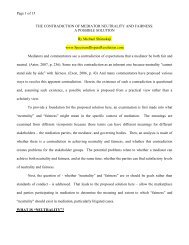

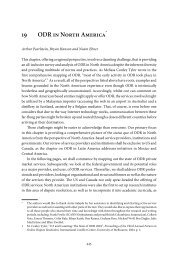
![Settlement Agreement Form [Agreement] - Mediate.com](https://img.yumpu.com/50682143/1/190x245/settlement-agreement-form-agreement-mediatecom.jpg?quality=85)

